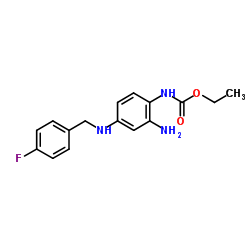The mechanism of action of retigabine (ezogabine), a first-in-class K+ channel opener for the treatment of epilepsy.
Martin J Gunthorpe, Charles H Large, Raman Sankar
文献索引:Epilepsia 53(3) , 412-24, (2012)
全文:HTML全文
摘要
The pharmacologic profile of retigabine [RTG (international nonproprietary name); ezogabine, EZG (U.S. adopted name)], is different from all currently approved antiepileptic drugs (AEDs). Its primary mechanism of action (MoA) as a positive allosteric modulator of KCNQ2-5 (K(v) 7.2-7.5) ion channels defines RTG/EZG as the first neuronal potassium (K(+)) channel opener for the treatment of epilepsy. KCNQ2-5 channels are predominantly expressed in neurons and are important determinants of cellular excitability, as indicated by the occurrence of human genetic mutations in KCNQ channels that underlie inheritable disorders including, in the case of KCNQ2/3, the syndrome of benign familial neonatal convulsions. In vitro pharmacologic studies demonstrate that the most potent action of RTG/EZG is at KCNQ2-5 channels, particularly heteromeric KCNQ2/3. Furthermore, mutagenesis and modeling studies have pinpointed the RTG/EZG binding site to a hydrophobic pocket near the channel gate, indicating how RTG/EZG can stabilize the open form of KCNQ2-5 channels; the absence of this site in KCNQ1 also provides a clear explanation for the inbuilt selectivity RTG/EZG has for potassium channels other than the KCNQ cardiac channel. KCNQ channels are active at the normal cell resting membrane potential (RMP) and contribute a continual hyperpolarizing influence that stabilizes cellular excitability. The MoA of RTG/EZG increases the number of KCNQ channels that are open at rest and also primes the cell to retort with a larger, more rapid, and more prolonged response to membrane depolarization or increased neuronal excitability. In this way, RTG/EZG amplifies this natural inhibitory force in the brain, acting like a brake to prevent the high levels of neuronal action potential burst firing (epileptiform activity) that may accompany sustained depolarizations associated with the initiation and propagation of seizures. This action to restore physiologic levels of neuronal activity is thought to underlie the efficacy of RTG/EZG as an anticonvulsant in a broad spectrum of preclinical seizure models and in placebo-controlled trials in patients with partial epilepsy. In this article, we consider the pharmacologic characteristics of RTG/EZG at the receptor, cellular, and network levels as a means of understanding the novel and efficacious MoA of this new AED as defined in both preclinical and clinical research.Wiley Periodicals, Inc. © 2012 International League Against Epilepsy.
相关化合物
| 结构式 | 名称/CAS号 | 分子式 | 全部文献 |
|---|---|---|---|
 |
瑞替加滨
CAS:150812-12-7 |
C16H18FN3O2 |
|
Enhanced in vitro CA1 network activity in a sodium channel β...
2014-04-01 [Epilepsia 55(4) , 601-8, (2014)] |
|
Safety profile of two novel antiepileptic agents approved fo...
2013-11-01 [Expert Opin. Drug Saf. 12(6) , 847-55, (2013)] |
|
Ezogabine (retigabine) and its role in the treatment of part...
2012-09-01 [Clin. Ther. 34(9) , 1845-56.e1, (2012)] |
|
[Retigabine - a new antiepileptic drug with a different mech...
2013-01-01 [Postepy. Hig. Med. Dosw. 67 , 973-81, (2013)] |
|
P-retigabine: an N-propargyled retigabine with improved brai...
2015-01-01 [Mol. Pharmacol. 87(1) , 31-8, (2015)] |